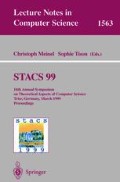Abstract
We present an approximation algorithm for the problem of partitioning the vertices of a weighted graph into p blocks of equal size so as to maximize the weight of the edges connecting different blocks. The algorithm is based on semidefinite programming and can in some sense be viewed as a generalization of the approximation algorithm by Frieze and Jerrum for the Max Bisection problem. Our algorithm, as opposed to that of Frieze and Jerrum, gives better performance than the naive randomized algorithm also for p > 2.
Access this chapter
Tax calculation will be finalised at checkout
Purchases are for personal use only
Preview
Unable to display preview. Download preview PDF.
References
Noga Alon and Joel H. Spencer. The Probabilistic Method. Wiley, New York, 1992.
Gunnar Andersson, Lars Engebretsen, and Johan Håstad. A new way to use semidefinite programming with applications to linear equations mod p. In Proc. Tenth Ann. ACM-SIAM Symp. on Discrete Algorithms, 1999.
Alan Frieze and Mark Jerrum. Improved approximation algorithms for MAX k-CUT and MAX BISECTION. In Proc. 4th Conf. on Integer Prog. and Combinatorial Optimization, volume 920 of Lecture Notes in Comput. Sci., pages 1–13, Berlin, 1995. Springer-Verlag.
Michel X. Goemans and David P. Williamson. 878-approximation algorithms for MAX CUT and MAX 2SAT. In Proc. Twenty-sixth Ann. ACM Symp. on Theory of Comp., pages 422–431. ACM, New York, 1994.
Johan Håstad. Some optimal inapproximability results. In Proc. Twenty-nineth Ann. ACM Symp. on Theory of Comp., pages 1–10. ACM, New York, 1997.
Richard M. Karp. Reducibility among combinatorial problems. In R. Miller and J. Thatcher, editors, Complexity of Computer Computations, pages 85–103. Plenum Press, New York, NY, 1972.
Luca Trevisan, Gregory B. Sorkin, Madhu Sudan, and David P. Williamson. Gadgets, approximation, and linear programming. In Proc. of 37th Ann. IEEE Symp. on Foundations of Comput. Sci., pages 617–626. IEEE Computer Society, Los Alamitos, 1996.
Uri Zwick. Approximation algorithms for constraint satisfaction problems involving at most three variables per constraint. In Proc. Nineth Ann. ACM-SIAM Symp. on Discrete Algorithms, pages 201–210. ACM-SIAM, 1998.
Author information
Authors and Affiliations
Editor information
Editors and Affiliations
Rights and permissions
Copyright information
© 1999 Springer-Verlag Berlin Heidelberg
About this paper
Cite this paper
Andersson, G. (1999). An Approximation Algorithm for Max p-Section. In: Meinel, C., Tison, S. (eds) STACS 99. STACS 1999. Lecture Notes in Computer Science, vol 1563. Springer, Berlin, Heidelberg. https://doi.org/10.1007/3-540-49116-3_22
Download citation
DOI: https://doi.org/10.1007/3-540-49116-3_22
Published:
Publisher Name: Springer, Berlin, Heidelberg
Print ISBN: 978-3-540-65691-3
Online ISBN: 978-3-540-49116-3
eBook Packages: Springer Book Archive

